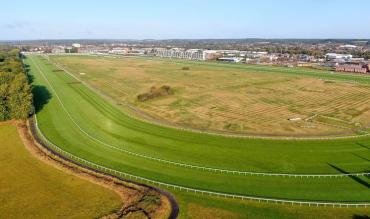Nestled in the Berkshire countryside, Newbury is a duel code racecourse that hosts both Flat and National Hunt racing.
The racecourse itself is a left-handed track up to one mile and seven furlongs in distance.
It has a very long home straight which comprises of a four-and-a-half furlong run-in which can be stamina sapping in heavy going for any horse and makes for very interesting sports betting.
Newbury Racecourse History
The first recorded racing at Newbury took place in 1805 with ‘Newbury Races’, an annual two day race meeting at Enborne Heath.
The meeting lasted until 1811 when it transferred to Woodhay Heath until 1815.
Newbury Racecourse as we know it now didn’t come into existence for another 90 years when Kingsclere trainer, John Porter proposed a new racecourse on the Newbury site.
The Jockey Club rejected Porter’s plans several times but a chance meeting with King Edward VII brought about the King’s support and the application was rubber stamped by the Jockey Club.
In April 1904 the Newbury Racecourse Company was formed and purchased the land and construction got under way. On September 26th and 27th, 1905 the first ever fixture took place at Newbury Racecourse.
Newbury Main Races
Newbury holds just one Group 1 flat race per season - the Lockinge Stakes.
The one mile contest is for horses aged four years and older has long been used by stables readying their horse to compete in the Queen Anne Stakes at Ascot.
The most famous thoroughbred to win both races in the same year was Frankel in 2012.
The National Hunt season at Newbury includes the famous Ladbrokes Trophy (the former Hennessy Gold Cup), which is run at the end of November, and the Betfair Hurdle, which has become a value handicap hurdle.
Both races are very popular with punters in the horse racing betting.
Newbury Racecourse Configuration
The flat course is an oval of one mile and seven furlongs but there are also one mile, and seven furlong chutes for the shorter sprints.
On the jump course, the circuit is just over one mile and three-quarters. A total of four stiff fences make up the home straight.
In addition to a jump course, Newbury’s steeplechase circuit includes a water ditch which is bypassed in the final circuit.
The jump course features seven flights with the emphasis very much on stamina.
Newbury Draw Bias
Newbury is a very wide track and the stalls are positioned in the middle of the track for 5 furlong to one mile races.
The draw advantage often follows the pace in the race and essentially there is no proper draw bias and horses can win from any draw.
Because Newbury is a big wide open course it is very hard for front runners to dominate and the majority of winners come from off the pace.
Getting To Newbury Races
-
By car: Newbury Racecourse, in Berkshire, is conveniently situated in the centre of the South of England, and easily accessible from Junctions 12 and 13 of the M4, from the M3 and A34.
-
By rail: Newbury Racecourse has its own station, one stop from Newbury Station with direct trains from London Paddington on major racedays. Once arriving at Newbury Racecourse station, racegoers have a short walk (1-2 minutes) to the course.
*Credit for the photos in this article belongs to Alamy*
